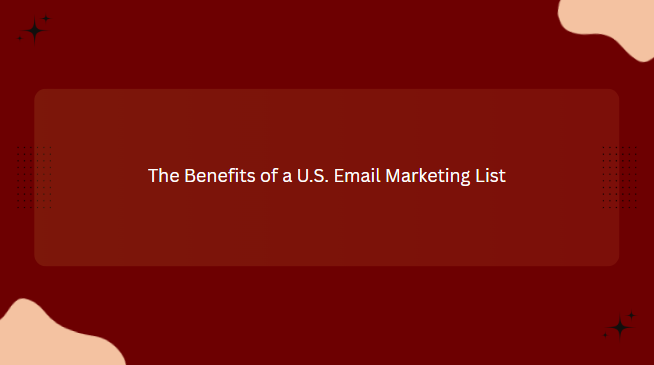Enhancing Targeted Marketing Strategies
One of the most valuable aspects of having a U.S.-based email marketing list is the ability to craft highly targeted campaigns. Rather than casting a wide net and hoping to attract interest, companies can segment their lists according to factors such as age, gender, income level, occupation, or purchase history. This level of specificity ensures that the right message country wise email marketing list reaches the right person at the right time. For example, a brand selling high-end electronics may focus on tech-savvy urban professionals, while a company offering family-oriented vacation packages may target suburban households with children. By tailoring content and offers, marketers increase the likelihood of conversions and build stronger brand loyalty. Furthermore, segmentation can be dynamic, adapting as customer behavior changes over time. A well-maintained U.S. email list enables A/B testing of subject lines, promotional offers, and content formats to continually refine marketing strategies. Over time, this leads to better click-through rates, higher open rates, and improved overall campaign performance.

Driving Cost-Effective Customer Acquisition
Email marketing remains one of the most cost-effective digital marketing channels, especially when utilizing a high-quality U.S. email marketing list. Unlike paid advertising, which often requires significant budgets for impressions and clicks, email marketing has relatively low distribution costs and can reach thousands—or even millions—of subscribers at once. The return on investment (ROI) for email marketing consistently outperforms many other marketing channels, largely due to its direct nature and the ability to nurture leads over time. A U.S.-specific list ensures that your resources are spent reaching individuals who are far more likely to engage with your offerings, thereby reducing wasted efforts. Additionally, email campaigns can be automated, allowing for consistent communication with subscribers through welcome emails, follow-up sequences, and promotional newsletters. This automation not only saves time but also ensures that every potential customer is touched at key moments in their buying journey. With the right analytics tools, businesses can track performance metrics in real-time and adjust strategies to maximize cost-efficiency.
Strengthening Customer Relationships and Retention
While email marketing is often associated with acquiring new customers, it is equally important for maintaining and strengthening relationships with existing ones. A U.S. email marketing list allows businesses to consistently communicate with customers, providing them with valuable content, updates, and exclusive offers. Regular engagement keeps your brand top-of-mind, increasing the likelihood of repeat purchases and long-term loyalty. For example, retailers can send personalized product recommendations based on past purchases, service providers can share tips and industry insights, and subscription-based businesses can offer renewal incentives. This ongoing communication fosters trust and positions your brand as a reliable partner in the consumer’s life. In the competitive U.S. market, where customers are inundated with marketing messages daily, staying connected in a meaningful way is crucial. Moreover, email allows for two-way communication—customers can reply with feedback, questions, or concerns, giving businesses valuable insights that can inform product development and customer service improvements.
Leveraging Data and Analytics for Continuous Improvement
Another major benefit of a U.S. email marketing list is the ability to gather and analyze data to drive continuous improvement. Every email campaign generates measurable metrics such as open rates, click-through rates, bounce rates, and conversion rates. By studying these indicators, businesses can gain a deeper understanding of what resonates with their American audience. For instance, analyzing data may reveal that certain subject lines perform better with specific demographics, or that promotional emails sent on particular days of the week yield higher engagement. Over time, these insights can be used to optimize future campaigns for maximum impact. Furthermore, advanced analytics tools allow for tracking customer behavior beyond the inbox, such as website visits, shopping cart activity, and purchase frequency. This creates opportunities for re-engagement campaigns, abandoned cart reminders, and loyalty programs tailored to the U.S. market. By leveraging data effectively, businesses can transform their email marketing list from a static database into a dynamic, revenue-generating asset that evolves alongside customer preferences and market trends.